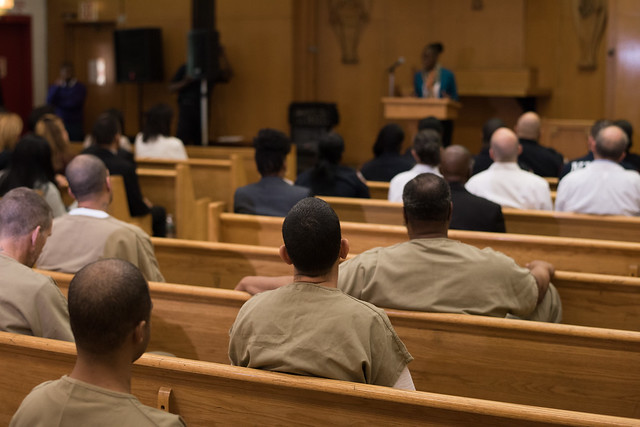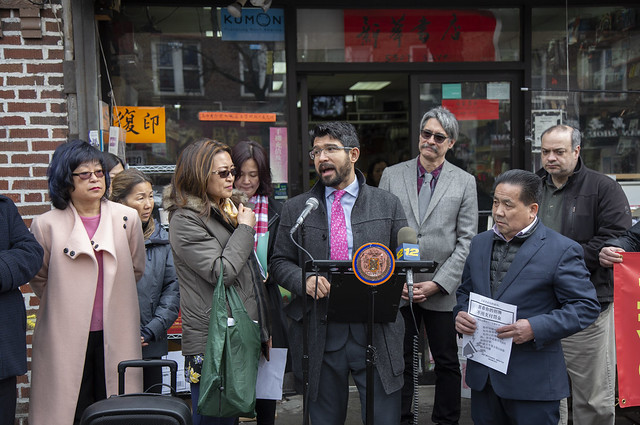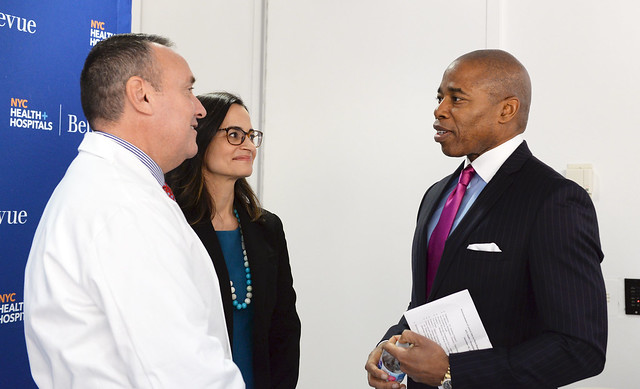How to Make New York’s New Criminal Justice Reforms Really Work

(photo: Michael Appleton/Mayoral Photography Office)
Change swept through Albany as lawmakers passed a suite of reforms aimed at reducing the harms inflicted by the criminal justice system. These changes, which include significant limitations on the use of bail and incarceration, will go a long way towards making our justice system less biased and more responsive to the needs of low-income New Yorkers and, in particular, people of color.
The next challenge that confronts us is how to move beyond simply avoiding harms and toward the creation of a positive vision of what justice should look like. If confinement can have lasting traumatic effects, and criminal records can create lifelong direct and collateral consequences, how should our law enforcement and justice system respond when people break the law? When someone commits a crime, what is the fair result? What makes a just outcome?
The answer to these questions depends upon the crime, of course. But we know that the standard response doesn’t work for victims, communities, or, most certainly, defendants. That’s why it is important to build new responses to the full range of offenses, from minor misbehavior to serious wrongdoing. And that’s exactly what New York City is doing. Three examples:
With the lowest-level crimes, we should try to divert as many people as possible out of the criminal justice system, minimizing the damage that a criminal record or jail can wreak on individuals, their families, and entire communities. But divert them to what?
Prosecutors in Manhattan, the Bronx, and Brooklyn, and the NYPD have an answer with Project Reset. People charged with low-level misdemeanors, such as shoplifting, can participate in a restorative justice group, arts-based workshop, or counseling session. If the participant completes the obligation -- and 98% do -- the district attorney declines to prosecute the case, the case is sealed, and the person never even has to show up to court.
Participants, who overwhelmingly describe the outcomes as fair, are less likely to reoffend when compared with a control group. The net effect is to create a proportionate, meaningful response to minor offending. By increasing the use of tickets instead of holding people in custody after arrest, the new state law opens the door even wider to Project Reset’s measured response to minor offending.
Supervised release -- an alternative to cash bail -- is another way that the justice system has calibrated its response to offending while minimizing negative effects. People held on bail make up a large portion of the Rikers Island population. They also are more likely to accept a conviction as part of a guilty plea than someone released to the public. Supervised release has enabled judges to safely release thousands of defendants to supervision monitored by non-profits, instead of holding them on bail.
Again, the system is finding a way to address a criminal event constructively, without defaulting to confinement, and in the process reducing the likelihood of a criminal record and the lifelong stigma that can follow. Now that New York’s new criminal justice laws will reduce reliance on money bail, supervised release may become an even more important bridge for closing the gap between release and detention when it comes to higher-risk individuals.
Finally, 18- to 24-year-olds make up roughly 25% of the criminal justice population. As we now know from brain science, the prefrontal cortex -- the part of the brain that governs executive function and impulse control -- may not be fully formed until a person’s mid-twenties, meaning that some adolescents and young adults are physiologically more likely to commit crime. While many of these individuals will literally age out of offending as their brains mature, if the system responds with confinement and conviction, their youthful crimes may make it harder for them to complete education, find jobs, and secure housing. So, how should the system respond?
The Brooklyn DA’s office has worked with the court system and defense advocates to provide 18- to 24-year-olds with community-based social services like mental health counseling and job training, instead of traditional punitive responses. Brooklyn’s young adult court, one of the city’s busiest courtrooms, has significantly reduced jail sentences and criminal convictions. And surveyed participants have overwhelmingly described the results as fair. Again, the system is responding with meaningful and constructive outcomes.
Project Reset, supervised release, and Brooklyn’s young adult court are just three of many new efforts to reduce the justice system’s dependence on confinement and redress historic inequities based on race and socioeconomic status, while ensuring public safety. In essence, New York City has begun to eliminate the unacceptable and, at the same time, lay the foundation for a justice system that responds to criminal behavior proportionately, meaningfully, and appropriately, with just outcomes. Albany’s new legislative reforms should enable the city to build on its current progress and further advance a new vision of criminal justice for New York.
***
Adam Mansky is Director, Criminal Justice, at the Center for Court Innovation. On Twitter @urbansdad & @courtinnovation.
***
Have an op-ed idea or submission for Gotham Gazette? Email This email address is being protected from spambots. You need JavaScript enabled to view it.
Industry City and the Police Power of Zoning

Council Member Menchaca and constituents (photo: John McCarten/City Council)
In the past week, the New York Post and New York Daily News published editorials criticizing New York City Council Member Carlos Menchaca’s March 6 request to delay the certification of a consortium of major real estate investors and developers’ application for a special permit to build two hotels and rezone Industry City for retail, office, and academic uses. The accusatory language in both newspaper editorials exhibits a deep contempt for the necessary public review of private development proposals.
This massive rezoning would greatly increase the density of commercial uses and allow three new buildings with 1.27 million square feet of market-rate, destination retail, hotel, and academic office space, and more importantly, will fundamentally and irrevocably alter the industrial working waterfront.
Menchaca and Community Board 7 requested more time for community review because “ULURP has historically failed to address the most urgent concerns voiced by the Sunset Park community.” A spokesperson was quoted in the RealDeal that Industry City “intend(s) to make our case” through the ULURP process but ultimately agreed to a postponement after Congressional Representatives Nydia Velázquez and Jerry Nadler, and State Senator Zellnor Myrie intervened with a letter to City Planning Director and Chair Marisa Lago.
The Post described Menchaca’s request as “holding Industry City hostage” in order to “blackmail” the developers for a “payoff to the activists.” The Daily News demanded that City Council members cease their “corrupting power on land-use matters” by pointing to Amazon’s February announcement of the withdrawal of a plan to build a massive campus in Queens. In concert with the Post, the Daily News similarly admonished Menchaca’s “meddling” and “extortion,” and demanded that he “must relent” and “the Council must end this craziness.”
I teach an introductory urban planning class and we spend weeks on the complicated topic of zoning. One of the first things we learn is that the legitimacy of zoning is based on the legal concept of municipal police power which refers to the right of the community to regulate the activities of private parties to protect the interests of the public. Menchaca requested a postponement in the certification of Industry City’s rezoning application in order to provide more time for a full vetting of public interests and concerns. This is not an unreasonable request especially as Menchaca’s letter notes displacement and gentrification concerns, and specifically requests Industry City to explain “how its rezoning proposal will mitigate displacement, gentrification, rising rents, congestion, and the effects of climate change.”
Despite indisputable evidence of Sunset Park gentrification including a NYU Furman Center study, the Post editorial repeated Industry City’s delusional claim that since its rezoning does not involve residential development, “it’s irrelevant to gentrification.” Industry City CEO Andrew Kimball’s letter stated that in order to have “modern manufacturing and making at Industry City,” the Special Sunset Park Innovation District rezoning must include “a mixture of uses that allow for a higher return.” And as page 6 of the Draft Scope of Work makes clear, Industry City needs the rezoning for “upscale” hotels, expanded destination retail, and new academic uses because without these city actions, it will not be able to raise $638 million in capital investment. Although Kimball argues that Industry City provides an antidote to gentrification through job creation, he has yet to specify the numbers, types, and wages of “high-quality” innovation district jobs that would be available to Sunset Park’s working age adults (of whom nearly one in two lack a high school diploma).
Industry City’s rezoning is essential to “generating the economic returns necessary to finance additional capital investment in the portfolio” in order to enhance and maximize property value and rent revenues (i.e., high-rent tenants).
As currently proposed, this rezoning will diminish one of New York City’s last remaining industrial waterfront neighborhoods, and as UPROSE Executive Director Elizabeth Yeampierre notes, it also represents a lost opportunity for a frontline community to advance innovation, inclusion, and resilience in the face of climate change. For these reasons and the right of Sunset Park’s Latinx-Asian working class to remain in the neighborhood, we must end the craziness of zoning in the service of the private market and enrichment of real estate developers rather than its intended purpose to protect the health, safety, and welfare of the public.
***
Tarry Hum is a professor at The City University of New York (CUNY) and author of Making a Global Immigrant Neighborhood. On Twitter @TarryHum.
***
Have an op-ed idea or submission for Gotham Gazette? Email This email address is being protected from spambots. You need JavaScript enabled to view it.
The Power to Prevent New Infections is In Our Hands

Brooklyn BP Eric Adams, the author (photo: Erica Sherman/Brooklyn BP's Office)
The world of medicine has advanced significantly in the battle against many chronic diseases, including the discovery of the polio vaccine and reversing the effects of diabetes and heart disease. However, one battle continues to be fought in research labs and on the ground in communities across America and around the world — the fight to end the HIV/AIDS epidemic.
While New York State has been a fearless leader on a national level in the effort to end this disease, Brooklyn remains the epicenter of a persistent health crisis. To tackle this head-on, the State set an ambitious goal of ending the epidemic by 2020. Thanks to the diligent work of advocates, community-based organizations, and health care providers, the target is within reach.
Yet statistics reveal a disturbing trend that must be addressed to complete the mission. Data from the New York City Department of Health and Mental Hygiene (DOHMH) reveals that 2017 HIV diagnoses were down to a record low of 2,157 citywide. Though this progress is encouraging, the rate of reduction is slowing, from an 8.6% decline in new diagnoses in 2016 to 5.4% in 2017. Brooklyn bears a disproportionate burden of the HIV/AIDS epidemic, with more than 30,000 of our neighbors living with HIV.
In 2017, our borough experienced 640 new HIV diagnoses, representing a 10.15% increase in new diagnoses from the previous year — making Brooklyn the only borough with an increase. Most alarmingly, Bedford-Stuyvesant and Crown Heights are the hardest-hit neighborhoods citywide, accounting for a quarter of new diagnoses in our borough.
Today -- Wednesday, April 10 -- we recognize National Youth HIV and AIDS Awareness Day. I continue to be concerned that each year since 2013 Brooklyn has more HIV diagnoses among youth aged 13-29 than any other borough. We owe it to our community’s young people to allow them to live in a world without AIDS.
We cannot let the promise of an end to HIV miss the mark by neglecting our most susceptible communities that have already been neglected through generational poverty, institutional racism, and unequal access to quality health care. We have tools at our disposal to end this epidemic, particularly by expanding Medicaid Special Needs Health Plans (SNPs), which are designed to address the needs of individuals living with or at higher risk for HIV. These specialized health plans help members access treatment so that the virus becomes suppressed or “undetectable,” meaning they are unable to transmit HIV to others.
The more people we help achieve undetectable status, the closer we are to a society without HIV and AIDS. SNPs also have the expertise to connect HIV-negative individuals with effective prevention methods such as pre-exposure prophylaxis (PrEP) and post-exposure prophylaxis (PEP) so they can remain negative, saving $1 billion in state Medicaid costs for every 2,000 new infections.
The sectors of the population most at risk for contracting the virus are certainly those who will benefit most from an expansion of this crucial program. The State’s “Blueprint to End the HIV/AIDS Epidemic by 2020” lists include men who have sex with men (MSM), people of transgender experience, women of color, HIV-negative partners in couples in which one person is HIV negative and the other is HIV positive, and people who are intravenous drug users as populations at higher risk for HIV.
To reduce the rate of HIV in Brooklyn and reach the 2020 eradication target, we must reach these vulnerable populations and ensure they receive the culturally competent services needed to remain HIV negative. At present, of the populations identified by the State as being at higher risk, only HIV-negative transgender individuals are currently eligible to enroll in SNPs. To reach the end of this epidemic, this must change.
Consider the clear scientific evidence that PrEP is more than 90 percent effective in preventing HIV transmission, yet the largest portion of New York State Medicaid recipients taking PrEP – 37% – are white gay and bisexual men despite black and Latino gay and bisexual men being hardest hit by the epidemic. We need to expand SNP eligibility and outreach to communities of color in the hardest-hit parts of our city to connect them to the services they need to get tested, treated, and enrolled.
We have the tools at our disposal to revolutionize the way we combat the HIV/AIDS epidemic. The power to prevent new infections is in our hands.
***
Eric L. Adams is the Brooklyn borough president. On Twitter @BPEricAdams.
***
Have an op-ed idea or submission for Gotham Gazette? Email This email address is being protected from spambots. You need JavaScript enabled to view it.




